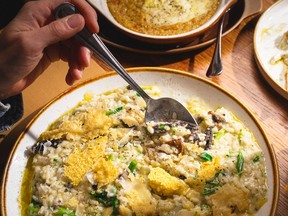Reviews and recommendations are unbiased and products are independently selected. Postmedia may earn an affiliate commission from purchases made through links on this page.
Fine Italian cuisine is thriving in Vancouver

Fine Italian cuisine is thriving in this city.

Article content
Pizza, pasta, prosciutto, Parmigiano-Reggiano — there’s a lot to like about Italian food.
Yet, ironically, there really is no such thing as Italian food. It’s a cuisine of regions and the sub-regions within them. After all, the multiple kingdoms, duchies and papal states that ruled the Italian peninsula only unified in 1871.
Article content
The rich, eggy pastas, buttery cheeses and cured pork dishes of Piemonte in the north are a world apart from the briny, sun-soaked olives, capers and tomatoes of Sicily in the south. In Calabria, food is flavoured with chilies, while in Liguria, it’s fragrant with delicate herbs, and in Tuscany, it’s simple, earthy and heavy on the beans, beef and olive oil.
Advertisement 2
Article content
And all of it is delicious, largely because it is made from the highest quality ingredients.
“That’s where I think the secret of Italy is. The authenticity … and the diversity,” says Carmen d’Onofrio, managing partner for the wine-importing company Stile Brands and chair of the planning committee for the Vancouver International Wine Festival.
“Italian food, design, wine — people always want to do their best because there is a lot of competition in Italy between the regions,” he adds. “The Venetians want to be better than the Tuscans, and Milan doesn’t appreciate Naples. Every region is unique and different in its own way.”
Sadly for us, we rarely have the opportunity to hop over to Rome, Florence or Venice to enjoy Italian food where it originated. Instead, we savour it here, through a distinctly North American lens. And that’s a whole different story.

Freshest ingredients
Chef Phil Scarfone remembers his Italian nonna putting up her tomatoes each summer back home in Toronto and making Sunday sugo with fennel sausage and pork neck every week. “She was very strict and would only serve it with penne rigate,” he recalls.
Advertisement 3
Article content
Unfortunately, he adds with a laugh, “I don’t think I learned a lot from her. I wasn’t interested in cooking then. I was interested in eating.”
Then four years ago, after a career of often experimental fine dining, he joined Banda Volpi, the restaurant group that comprises Osteria Savio Volpe, Caffe La Tana, Pepino’s Spaghetti House and Osteria Elio Volpe, which will open soon.
Now, Scarfone says, “I love Italian cuisine. It’s the most delicious use of fresh ingredients I can find. I see it more as an approach than as a cuisine. You want things to be delicious and you don’t want to get in the way of perfect ingredients. It’s a dream, to be honest.”
Local farmers bring him their best produce, which determines what will go on the menu that day. But he also gets to oversee three — and soon four — restaurants, each with its unique personality.
“It’s an exciting role for me because I can choose what I want to do — I can make old-school Italian or more North American modern Italian, or the hearty rustic vibe of Savio Volpe,” he says.
Caffe La Tana, for instance, is a traditional pasta and wine bar. Pepino’s captures that mid-century North American-Italian vibe. The new Elio, which will be located at 17th and Cambie in Vancouver, will be like a sunny breeze from the south with lots of bright flavours and fresh seafood.
Article content
Advertisement 4
Article content
As for Savio Volpe, which features wood-fired meats and pasta made fresh in house every day, “In summer, we’re a southern Italian restaurant, with tomatoes and fresh vegetables. And in winter we’re a Northern Italian restaurant with all the butter and cream and heartier vegetables.”
You could almost trace the history of Vancouver’s Italian scene in those four restaurants.


Thriving on the Drive
The first Italians came to Vancouver before there even was a Vancouver, arriving in the 1880s to work on the Canadian Pacific Railway.
They were followed from 1896 to 1914 by the first major wave of Italian immigrants, who settled mainly in Strathcona, where they opened groceries and restaurants in the young city’s first Little Italy. Among them were names that are still familiar today, even if they have moved to new neighbourhoods, like Tosi Italian Food Importers and Bosa Foods.
The next — and much larger — wave arrived after the end of the Second World War, between 1947 and 1973, mostly from Calabria and other southern regions.
By then, the Italian community had spread across East Vancouver. Commercial Drive became the heart of the new Little Italy. Nick’s Spaghetti House — now Pepino’s — opened here in 1957; Cafe Calabria in 1976; La Grotta Del Formaggio in 1977. That same year saw the first Italian Days festival on the Drive. Even now, the Drive is where footie fans come to celebrate every time the Azzurri win the World Cup.
Advertisement 5
Article content
The restaurants, bars and cafés were gathering places for the community to celebrate, gossip, dance and for older men to while away the hours playing cards. It was a lively and vibrant scene in an otherwise strait-laced city.
The food they served was also considered exotic in a city with a strong British heritage.
“Originally, most of the Italians who came to Canada were from southern Italy, so it was a lot of pizza and spaghetti and meatballs,” says d’Onofrio, whose family was an important part of the community on the Drive and among the first to bring in higher quality Italian products. “Now you see more Northern cuisine and coastal cuisine.”
La Dolce Vita
For that, you can probably thank the Tuscan-born Umberto Menghi.
He arrived in Vancouver in the early 1970s and soon after opened his legendary restaurant in the little yellow house on Hornby Street. At a time when Italian typically meant tomato sauce under a layer of molten cheese, he introduced the kind of lighter dishes, fresh ingredients and luxury products we associate with Italian food today.
Now fine Italian cuisine is thriving in this city: at Cioppino’s, whose chef-owner, Pino Posteraro, has been named a Guardian of Tradition by the magazine Gambero Rosso; at Giardino, the reincarnation of Menghi’s original garden restaurant; at Lupo, CinCin Ristorante, Acquafarina, Di Beppe, Bar Corso and so many others.
Advertisement 6
Article content
And the food they serve is no longer just Italian — it’s Friulian at Carlino, Venetian at Bacaro, Florentine at Fiorino.
“It’s become much more diversified,” says d’Onofrio. “Chefs are also much more adventurous in style, in ingredients, in putting their own mark on dishes. The best can do comfort food and elevate it, too.”
They also capture that ineffable sense of la dolce vita, the sweet life, especially at cheerful wine-and-food bars like Caffe la Tana and Bar Corso, throwbacks to the heyday of the Drive, but with an elevated menu and wine list.
After all, d’Onofrio says, “Wine is a food group in Italy. You decide what you want to eat with what you want to drink. Wine and food never compete against each other. It’s always complementary. The purpose is to elevate each other.”
Mostly what he sees, though, is a deep appreciation for craftsmanship, quality and authenticity. “When you’re authentic and true to your terroir and region, you will have a bright future. Because your roots are deep, when there is a storm, you will be able to withstand it.”
And, he adds, “There’s never a substandard product in Italy.”
Advertisement 7
Article content

Recipe: Wild Mushroom Risotto
Recipe by chef Phil Scarfone, culinary director of Banda Volpi (Osteria Savio Volpe, Caffe La Tana, Pepino’s Spaghetti House).
8½ cups chicken stock or vegetable stock
1 cup unsalted butter, divided — 10 tbsp. for risotto plus 4 tbsp. to roast mushrooms, plus 2 tbsp. to finish
1 rib celery, finely diced
½ red onion, finely diced
½ leek, rinsed and finely diced
5 cloves garlic, finely chopped
1½ tsp. kosher salt or to taste
10 oz. wild or cultivated mushrooms, washed if necessary, cut into roughly 1-inch pieces
2¼ cups arborio rice
1 tbsp. porcini powder, if available
1½ cups dry white wine
3.5 oz. truffle pecorino, or pecorino romano if not available
¼ bunch parsley, chopped finely
Pour stock into a medium-sized pot and warm over medium-low heat as you prepare the rest of the risotto.
Heat a wide, heavy-bottomed pot over medium-low heat.
Add 10 tbsp. butter and melt halfway, add onions, garlic, celery and salt. This will be the sofrito, the aromatic base for the risotto.
Cook over low heat and be patient. You must cook this sofrito until it is very, very soft, approximately 15 to 20 minutes, stirring occasionally. The vegetables must not brown, only soften and bubble away slowly.
Advertisement 8
Article content
Meanwhile, place 4 tbsp. butter into a separate large skillet and heat over medium-high heat until butter is melted and foamy.
Add mushrooms to the skillet and cook over medium high heat until caramelized but not dehydrated, approximately 7 to 10 minutes. Transfer to a paper-towel-lined plate using a slotted spoon to leave excess butter behind. Make sure you’re taking a second here and there to stir your sofrito pot.
Back to our risotto:
Add rice and increase heat slightly. Toast rice, stirring with a wooden spoon until evenly coated with butter. This should take 3 minutes.
Once rice is toasted, add the porcini powder, if you are using it, and stir gently. Follow with the wine and continue to stir gently.
The mixture will become creamy. Keep stirring gently, ensuring you make contact with every square inch of the bottom of your pot — do not leave unattended. Once the alcohol has cooked off, approximately 5 minutes, add 4 cups of hot stock and the roasted mushrooms. Stir mixture gently and consistently.
Keep adding stock as it is absorbed by the rice. Do not leave the pot, and continue stirring almost constantly, adding stock a cup at a time. When you add the final bit of liquid, the mixture must be loose and flow like lava.
Remove from heat and finish risotto off the heat with freshly grated truffle pecorino, chopped parsley, butter and salt to your taste.
Any leftover risotto can be chilled in the fridge overnight and made into arancini the next day.
Serves 4.
Article content
Source: vancouversun.com

